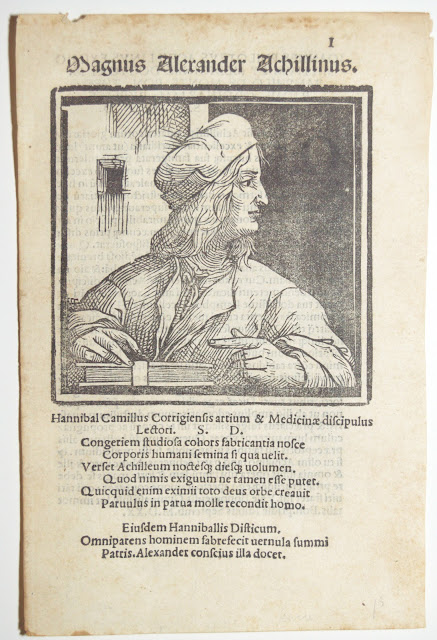Six reasons why you should buy Antique prints!
1. You get to own a piece of history
You can own something that was made over a hundred years ago. It may have even passed through some famous hands!
2. Aesthetically Pleasing
There is such a range of styles and subject matter to antique prints; there is something for everyone!
From 16th Century Woodcuts:
Magnus Alexander Achillinus.
[Bologna, Hieronymum de Benedictis, n.d., c.1520.]
Very scarce woodcut, set in Latin text. Sheet 205 x 135mm (8 x 5¼"). Small notch in top edge, slight spotting.
An early portrait of Alessandro Achillini (c.1463-1512), philosopher and physician of Bologna, who studied anatomy. It was published as the frontispiece to 'Annotationes anatomiae magni Alexandri Achillini Bononiensis', first published 1520.
Wellcome 8-1.
[Ref: 57195] £360.00
[Bologna, Hieronymum de Benedictis, n.d., c.1520.]
Very scarce woodcut, set in Latin text. Sheet 205 x 135mm (8 x 5¼"). Small notch in top edge, slight spotting.
An early portrait of Alessandro Achillini (c.1463-1512), philosopher and physician of Bologna, who studied anatomy. It was published as the frontispiece to 'Annotationes anatomiae magni Alexandri Achillini Bononiensis', first published 1520.
Wellcome 8-1.
[Ref: 57195] £360.00
To modern etchings:
[Falcon.]
[Edward Julius Detmold. & Charles Maurice Detmold]
Unsigned etching issued in The Artist Engraver, April 1904
Etching. Plate 230 x 173mm. 9 x 6¾".
This was the first commercially published etching by the Detmold twins and attracted considerable attention. A collaboration that saw them elected as associates of the Royal Society of Painter-Etchers and Engravers in the sinter of 1904. A bird of prey perched on a trunk with its wings in a defensive position squawking. The sun creates a halo behind the head. Edward Julius Detmold (1883-1957) was twin brother to Charles Maurice Detmold (1883-1908). The pair were among the artists associated with the Golden Age of Illustration. They worked together making sketches at the Zoological Gardens and exhibited together from the age of fourteen. He became one of the best Edwardian animal illustrators, known for his subtle placement of animals within their natural environment. Edward expressed artistic versatility and published a number of books of fine fantasy drawings in the 1920s; they portrayed a vivid imagination and he utilised warm colouring, which suited the period. The Jungle Book (1908) was to be the last substantial commission that the brothers worked on - due to the death of Charles in that same year. The extraordinary success of their illustrations to accompany Kipling's classic tale, however, firmly established the reputation for Edward and the following year, a suite of illustrations prepared to Aesop's tales were published in The Fables of Aesop (1909).
[Ref: 17296] £280.00 (£336.00 incl.VAT)
[Edward Julius Detmold. & Charles Maurice Detmold]
Unsigned etching issued in The Artist Engraver, April 1904
Etching. Plate 230 x 173mm. 9 x 6¾".
This was the first commercially published etching by the Detmold twins and attracted considerable attention. A collaboration that saw them elected as associates of the Royal Society of Painter-Etchers and Engravers in the sinter of 1904. A bird of prey perched on a trunk with its wings in a defensive position squawking. The sun creates a halo behind the head. Edward Julius Detmold (1883-1957) was twin brother to Charles Maurice Detmold (1883-1908). The pair were among the artists associated with the Golden Age of Illustration. They worked together making sketches at the Zoological Gardens and exhibited together from the age of fourteen. He became one of the best Edwardian animal illustrators, known for his subtle placement of animals within their natural environment. Edward expressed artistic versatility and published a number of books of fine fantasy drawings in the 1920s; they portrayed a vivid imagination and he utilised warm colouring, which suited the period. The Jungle Book (1908) was to be the last substantial commission that the brothers worked on - due to the death of Charles in that same year. The extraordinary success of their illustrations to accompany Kipling's classic tale, however, firmly established the reputation for Edward and the following year, a suite of illustrations prepared to Aesop's tales were published in The Fables of Aesop (1909).
[Ref: 17296] £280.00 (£336.00 incl.VAT)
3. Environmentally Friendly
Essentially you are buying second hand which is better for the environment. Check out our blog post for more information on this!
4. Antiques last a long time
They've survived this long why wouldn't they last longer! Contemporary items seemed to be manufactured with an expiry date so they break after a few years to get you to buy more. With proper care these prints will most likely last another couple of hundred years.
5. Budget friendly
Tsetinje.
Hanhart lith.
[London: Richard Bentley, Publisher in Ordinary to Her Majesty. 1864.]
Coloured lithograph, sheet 150 x 235mm. 6 x 9¼". Stain upper left and right.
From "The Eastern Shores of the Adriatic in 1863. With a Visit to Montenegro", by the Viscountess Strangford, Emily Anne Beaufort.
[Ref: 10298] £50.00 (£60.00 incl.VAT)
Antique prints range in price and there are definitely items to suit
all budgets. We have some prints within our uncatalogued folders for
around £10 and a special under £30 London folder. If you use our website's advanced search you can check the 'Under £100' box.
6. Its an investment
Antiques often gain value over time. You could buy a piece now and potentially sell it for a profit down the line or you could pass it down for generations.





